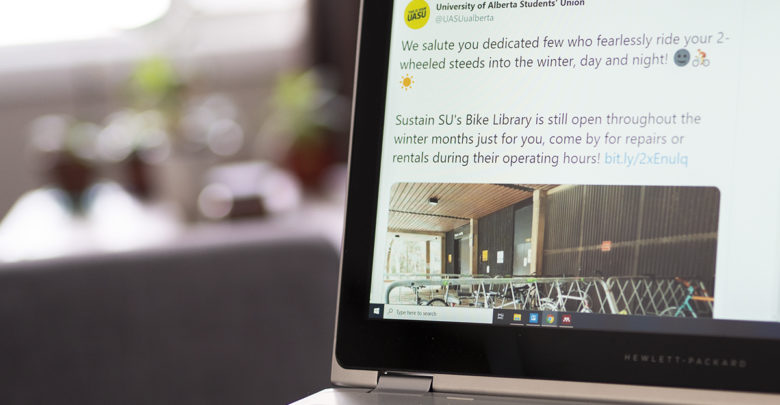 Helen Zhang
Helen ZhangOver the past academic year, myself and others have noticed the Students’ Union (SU) unsuccessfully attempting to appear relatable in their promotional materials. Whether it’s basing an entire event off an outdated Area 51 meme, calling bikes “two-wheeled steeds”, or a particularly bad “Ok, Boomer” reference, the SU consistently tries to appear trendy and youthful. However, not only do these attempts come across as cringey, they indicate a bigger issue: that Students’ Union and the executive team that runs it aren’t relatable to everyday students.
The moment that best encapsulates this was the SU’s marketing response to the Alberta Government’s cuts to post-secondary funding last fall. While these cuts presented a dire situation for many post-secondary students, you wouldn’t know that based off the light-hearted and “youthful” marketing of the SU. With the cuts announced right around Halloween, the SU sent out a newsletter labeling the budget as “spooky,” and promoted a student protest march through a series of memes online. Then, after the SU Executive team was called out for posing in a photo-op with the Advanced Education Minister the morning of the march, they responded cheerfully that students shouldn’t “be fooled by [their] grins, there’s fire behind those eyes.”
Of course, seeing organizations use memes and playful language in digital marketing is not entirely uncommon. This tactic, referred to as meme marketing, is often utilized by corporations in order to connect with younger generations, who are perceived as being ad-averse. What is odd, however, is why the SU would need to invoke these specific marketing techniques in the first place, given that they are a student-run organization. In theory, elected SU executives should have no problem connecting and relating to other students, given that they themselves are students.
However, the SU’s meme marketing calls into question how relatable our SU executives actually are. A reason why executives might struggle to relate to other students is because they spend minimal, if any, time in a classroom. While executives are required to be enrolled students, it’s well known that executives usually enroll in only one course in order to have more time to carry out their executive duties. Additionally, many executives withdraw from their singular course after the add-drop deadline, leaving them without any classes at all.
While many justify this by explaining it gives executives more time to advocate for students, which is a full-time job, this nonetheless puts them at a distance from the experiences of students. After all, most students must balance classes alongside their extracurriculars and jobs. Additionally, many low-income students have to work full-time in order to pay for school and, unlike executives, aren’t likely to receive well-paying jobs as lobbyists after graduation as a result of their full-time commitments. As such, most students cannot relate to the SU executives who represent them.
If the SU wants to be more relatable, I would advise them to stop using meme marketing, and instead to immerse themselves in the experiences of students. A good way to start this would be to re-direct the attention given to marketing to other services which actually address students’ needs. For example, by re-directing funds away from marketing and towards services like the Peer Support Centre, which currently receives less than three times the funding of the SU’s marketing department, the SU could better address pressing concerns surrounding mental health on campus.
Instead of spending time online justifying photo-ops with government ministers, executives could spend their time rebuilding the SU’s relationship with Indigenous students by implementing more recommendations from the Aboriginal Relations and Reconciliation Committee, especially considering they’ve only completed 12 out of sixty-seven recommendations to date.
Listening to students and addressing issues like these are how the SU becomes relatable, not by sharing outdated memes.




